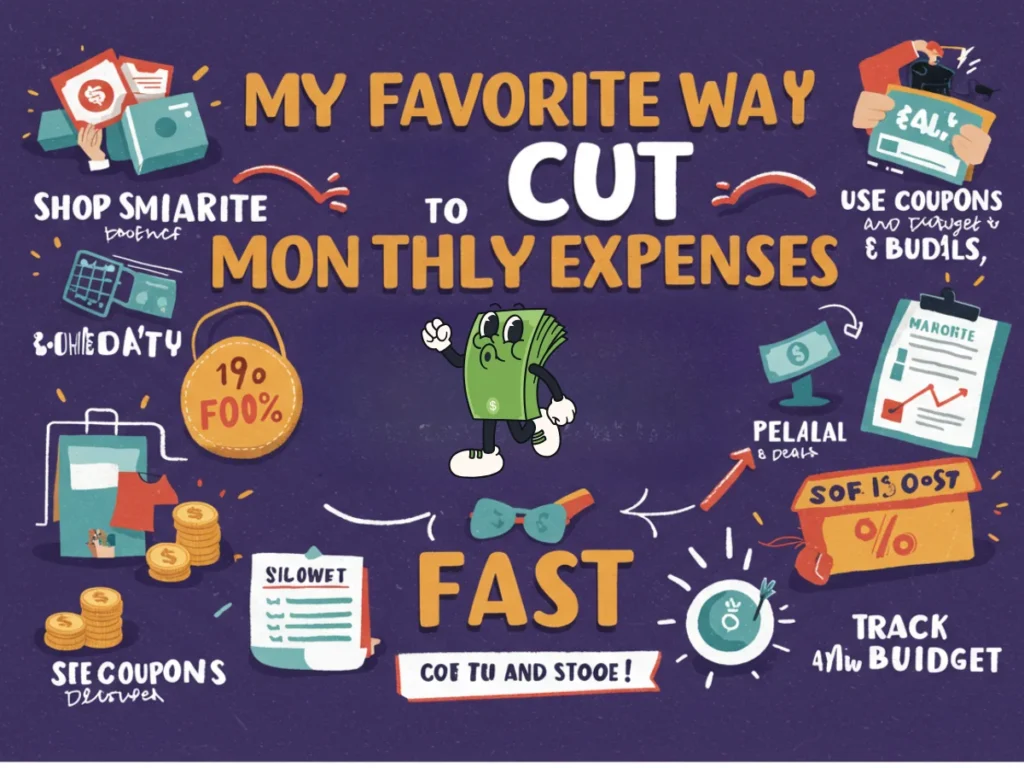A while back, I was tired of living paycheck to paycheck. I wasn’t making a lot, and by the end of the month, my bank account always felt empty. I wasn’t blowing money on huge stuff either — it was just all the little things adding up: streaming subscriptions, eating out, random shopping.
So I made a choice. I didn’t want to feel broke anymore. I wanted to keep more of the money I worked so hard for. That’s when I decided to look at my monthly expenses and see what I could cut — fast. I didn’t want to feel deprived or live like a monk. I just wanted to be smarter.
Here are my favorite ways I cut my monthly expenses quickly — and how you can too.
1. I Canceled Subscriptions I Didn’t Use

This was the first thing I did. I opened my bank app, looked at my recent charges, and found out I was paying for stuff I didn’t even remember signing up for.
- A streaming service I hadn’t used in months
- A fitness app I never opened
- A cloud storage plan I forgot about
Altogether, these were costing me about $45 a month. That’s over $500 a year!
What I did: I canceled anything I hadn’t used in the last month. I kept one streaming service I actually watch, and got rid of the rest. I can always sign back up later if I really want to.
2. I Stopped Eating Out All the Time
Eating out was a habit I didn’t even realize I had. Lunch at work. Coffee in the morning. A snack run in the evening. All those “small” buys added up.
- $12 lunch
- $5 coffee
- $7 fast food dinner
That’s $24 in just one day. Multiply that by a few times a week, and it’s no wonder my wallet was always empty.
What I did: I started packing my lunch 4 days a week and bringing my coffee from home. I still treated myself now and then, but way less. This saved me around $150 a month just by being more prepared and skipping a few takeouts.
3. I Switched to a Cheaper Phone Plan
I used to pay $80 a month for my phone. I didn’t even use all the data they gave me. So I looked into prepaid plans and smaller carriers.
Guess what? I found a plan for $25 a month with plenty of data, talk, and text. Same phone. Same coverage in my area. Just way cheaper.
What I did: I called my provider, checked my usage, and compared cheaper plans online. I switched within one day and saved $55 a month, which is $660 a year.
4. I Shopped with a Grocery List
Before, I’d walk into the store hungry and grab whatever looked good. Chips, cookies, frozen meals, “2 for $5” deals I didn’t need. The bill would shock me every time.
What I did: I made a simple list before going to the store. I stuck to it. I also planned 3–4 meals for the week so I didn’t waste food. This cut down impulse buys and saved me about $100 a month. Also, I started looking at store-brand items. Same taste, lower price.
5. I Used Cash for “Fun” Spending
One trick that helped a lot was using cash instead of my debit card for things like snacks, coffee, and outings.
Every week, I’d take out $40 cash. That was my spending limit for non-essentials. When the cash ran out, that was it for the week.
What I did: This helped me see the money leave my hand. It made me pause before spending. And because I was more aware, I spent less — about $50 to $75 less per month just by setting a physical limit.
6. I Unplugged Energy Wasters
My electric bill was higher than it needed to be. I found out that even when electronics are “off,” they still use energy when plugged in — things like my TV, game console, laptop charger.
What I did: I unplugged devices when I wasn’t using them and turned off lights in empty rooms. I also started washing clothes in cold water and air-drying when I could. These changes dropped my power bill by $20 to $30 a month.
Bonus: it’s good for the planet too.
7. I Bought in Bulk (But Only Smart Stuff)
Buying in bulk can save money — but only if you’re smart about it. I started buying things I always use in larger packs:
- Toilet paper
- Rice
- Pasta
- Shampoo
- Toothpaste
What I did: I avoided stuff that would expire fast, like snacks or produce. For the essentials, I saved a few dollars every time by buying big sizes or multi-packs. It added up to about $20–$30 savings per month.
8. I Delayed Big Purchases
Impulse buying was one of my biggest money traps. I’d see something online — a jacket, a speaker, a kitchen gadget — and feel like I needed it now. I’d buy it, then regret it.
What I did: I started a rule: wait 48 hours before buying anything over $25. I’d add it to my cart and leave it there. If I still wanted it after two days, and I could afford it, I’d consider buying it.
Most of the time, the urge passed. This habit saved me about $100–$200 a month, depending on how many random things I avoided.
9. I Used Free Entertainment Options
Before, I spent money going out every weekend — movies, events, restaurants. It was fun, but expensive.
What I did: I started looking for free things to do:
- Movie nights at home
- Library books and games
- Walks at the park
- Free events in my town
- Game nights with friends
I still had fun. I just didn’t have to spend $50 to do it.
Result? I saved around $60 a month on entertainment, and still enjoyed my weekends.
10. I Set Monthly “No-Spend” Goals
Each month, I picked something I spent too much on and challenged myself to go without it for 30 days.
One month: no takeout.
Another month: no online shopping.
Another: no coffee shop drinks.
These little goals helped me break bad habits and saved me $100 or more per challenge.
I didn’t cut everything all at once. Just one focus at a time. It was kind of fun, like a game. And the money I saved? Straight into my emergency fund.
Final Thoughts
None of these changes were huge. I didn’t move to a cheaper city or stop having fun. I just got more intentional. I made simple swaps and paid more attention. That’s it.
And guess what? Within the first 3 months, I was saving about $500 a month — without feeling like I gave up everything.
Here’s a quick summary of what worked for me:
- Cut subscriptions I didn’t use
- Ate out less, cooked more
- Switched to cheaper plans (phone, internet)
- Used lists when shopping
- Switched to cash for fun spending
- Saved energy at home
- Delayed big purchases
- Chose free fun
- Made monthly “no-spend” goals
If you want to save more each month, start small. Try one or two of these ideas. Don’t aim for perfect. Just aim to spend less than you earn — and you’ll be amazed how fast your money adds up.
Check this out:
How to Launch a Cleaning Business and Earn £500,000 Annually
Starting a Vending Machine Side Hustle: Steps to Achieve $900 Monthly Income
A Guide to Profitable Reselling Businesses: From Zero to $20,000 a Month
